FF Topics
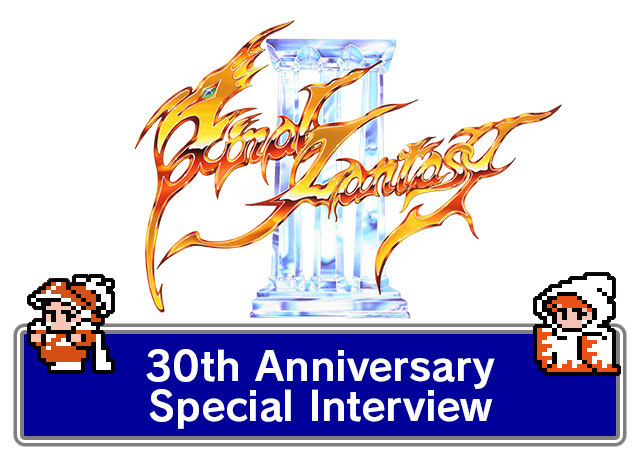
FINAL FANTASY III 30th Anniversary
Special Interview Vol.1
This article was published in 2020.
April 27 marks 30 years since FINAL FANTASY III was released! We interviewed Hiromichi Tanaka and Koichi Ishii, two game creators who have extensive knowledge about FFIII’s creation.
Recollections of FFIII’s development, behind the scenes secrets – you’ll get lots of info here you can’t find anywhere else!
In part one, we asked Hiromichi Tanaka how he came to be involved in the FINAL FANTASY series games and about his role in the development of FINAL FANTASY III!
You can read part two of the FFIII 30th Anniversary Special Interview with Mr. Koichi Ishii here.Hiromichi Tanaka Profile
Game creator involved in many titles, including FINAL FANTASY III, Secret of Mana and Xenogears. Still actively involved in the game industry at GungHo Online Entertainment, Inc.!
―First, we’d like to ask how your involvement in the FINAL FANTASY (hereafter FF) series of games came to be.
Tanaka: Back then, Square was initially located in Hiyoshi, Yokohama before moving its headquarters to Ginza, Tokyo. Mr. [Koichi] Ishii and Ms. [Kazuko] Shibuya began creating games in a small office there, and that’s how FF got its start. The owner of Square at that time was Mr. [Masafumi] Miyamoto, and at a gathering for this game creators’ association called SST (Super Software Team) at CES, a tech industry event outside Japan, he met a programmer named Nasir Gebelli who made Apple II games by himself. They talked together about all these incredible dreams they had and immediately hit it off. Mr. [Hironobu] Sakaguchi, myself and other people in the company were Apple II users, so we were familiar with him and even had some of his software. He was known for putting together really high-quality programs, so it was kind of an, “Ah!! Yeah yeah, that guy!” moment. [laughs]
Through that Nasir came to join us. Together, we first made The 3-D Battles of WorldRunner, then our second work was Rad Racer. FFI was the project we started once we had decided to really put together a serious game using this new programmer.
Having made an RPG called GENESIS (Japan exclusive) for PCs like the PC88, PC98 and FM-7, I had experience with RPGs, but at the time of FFI’s creation I was involved in a game called Square’s Tom Sawyer (Japan exclusive).
Nasir had experience creating arcade action games, but he didn’t have much knowledge of RPGs – or maybe it might be better to say that he didn’t really know how to go about making one. So they brought me on to do data design, game design, tables of experience points, all that kind of stuff, and then I’d have him put together the program itself. That’s how I ended up involved in FFI.
―What kind of concept was there for FFIII when the project first started?
Tanaka: With FFI and FFII having successfully released, we got into talks of making another sequel. Mr. Ishii did the screen design for FFI, but that was a multi-window design, right? There was the monster box, the box where the player team is, the message box, the parameter box. In FFII, we got rid of some of that and went with a design that makes it look like the monsters and player are on the same plane. Also, FFII was a Mr. [Akitoshi] Kawazu-esque story-focused game. When we began work on FFIII, there were already whispers starting to go around of the SNES and we had learned how to make good use of the NES, plus carts had gotten to megarom data sizes that were about double that of FFII. So we were making FFIII with the mentality of pushing the amount of data that can be packed into these carts to its utmost limits. There was also the job change system. For FFI we called it the class change system, but the way they changed from a small character to an adult character, from a sprite size of about two heads to three, just wasn’t cute at all. So yes, we decided to drop class change and go with job change. [laughs]
―What parts of FFIII were you primarily responsible for?
Tanaka: Most of the game system planning for the project – essentially everything but the story. I did overall system data design for FFI, and in FFII, scenario event planning and battle design such as the character leveling system were left up to Mr. Kawazu. With FFIII Mr. Sakaguchi started writing the story, so I handled everything not related to that – battle, menus, system design, all of that.
―We learned that the job designs in FFIII came largely from Mr. Ishii’s involvement, but there were a lot of really memorable monsters too.
Tanaka: Monster design and data was handled by Mr. [Kazuhiko] Aoki. He’s a fan of Western naming, so monsters like Yormungand came from him. I did the formatting for monster data and all the player data design, then gave the data and stat balances to him and had him make the monsters he wanted based on that.

―It feels to us that FFIII has a reputation for being game mechanics-heavy...
Tanaka: That’s because Mr. Kawazu wasn’t involved. [laughs]
When Mr. Kawazu creates stories, they have a certain distinctive characteristic to them, so his involvement often has a tendency for that game to be remembered as story-heavy.
―Were the world design concepts for FFIII, for example the floating continent, there from the beginning of development?
Tanaka: Well, while making FFIII we shared a kind of collaborative collection of ideas amongst the whole team. The part when you leave the first continent and the world map outside is this unbelievably vast space, that came from those notes. Summons, too. We made this notebook of game ideas, and there was an element of taking things from there and figuring out how to implement them into the story. Although we did think it was a bit of a stretch that this continent that was on the bottom of the sea surfaced and all of a sudden everyone there is just living their lives like nothing had ever happened. [laughs]
―Yeah, it’s a little surprising how everyone just accepted it at the time...
Tanaka: We were actually worried about that – “Is this okay to include? Will it be alright?”
―FFIII is also known for having many methods for the player to get around the game world.
Tanaka: The airship in FFIII was incredibly fast compared to FFI and FFII, right? At the time there was this game with high speed scrolling called Xanac (created by Compile), and I showed it to Nasir and discussed with him whether it was possible do scrolling around that speed. Then, in one night, he put together code for scrolling at around the same speed as Xanac on the overworld map. So we told him, “Okay, we’ll go with that,” and created the fastest airship.
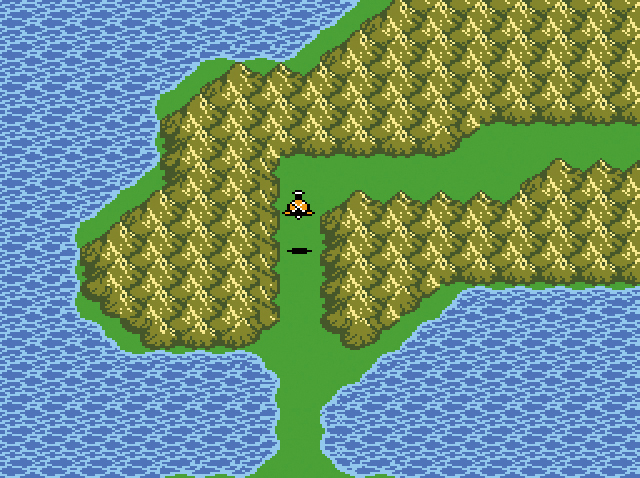
―Even aside from that, the variety of vehicles, like the airship Invincible, was incredible.

Tanaka: That was all taken from everybody’s notebook of game ideas as well.
―Moogles made their first appearance in FFIII. What did you think of that character when you first saw it?
Tanaka: How do I say this – it’s not a character that I remember at the time being in a special or important position, or even particularly memorable. It was just one character of many, and we added it in because we wanted someone to put in these caves. It was a race of cave people; we didn’t think it would become a mascot character. [laughs]
Mr. Ishii had said something about infravision [*a term from Dungeons & Dragons that refers to “night vision”], but it ended up not meaning much within the setting of the game. I think it had to do with their eyes being specially adapted to darkness because they lived in caves, or something like that. [laughs]
―The summon system was also a first in FFIII.
Tanaka: When the battle field is made into one area, there’s a visual difference between the player side and the monster side, with Mr. Amano’s monster designs on one end and Mr. Ishii’s character pixel art on the other. We wanted to place something monster-like on the player’s side too, to create a visual that pits monster versus monster, and so from that I suggested including summons. The first one we created was the Zantetsuken-wielding Odin.
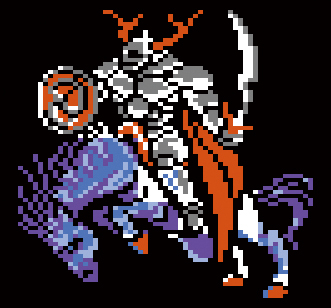

Odin’s visual design came from a picture that happened to be in Mr. Amano’s illustrations of a man riding a horse which looked close to the design we wanted. I can’t remember exactly why we decided he uses Zantetsuken; there were even people on the development team saying, “Doesn’t Odin always use a spear?” [laughs]
Getting into the technical side of things, before FFIII when we were making Rad Racer, at that time we were developing for cathode ray tube screens, so to animate the road turning we would integrate scrolling by individual scanlines. Using the same technique, for Odin’s attack we realized perhaps we could shift the scanlines in the middle of the display and make it look like the screen is splitting in half. I figured we could slide the top and bottom parts of the monster to make it look like it’s been cut into two pieces. That’s why the place where monsters sit on the battle screen is only black, while the location graphics were put up top. To do that kind of visual on NES we couldn’t use layers, it had to be one big sprite image. So if the monsters were displayed with a background behind, that would have been split into two as well. We made the background black to avoid that.
―How were the other summons decided?
Tanaka: I think we just took choices that felt like summons from the monsters we had and gave the appropriate background and story information to Mr. Amano to draw. I want to say a lot of it was added later on in development.
―Which summon leaves the biggest impression for you now?
Tanaka: I suppose Odin, the one we made first.
―Which came first, summons or the summoner job?
Tanaka: I believe the job came first. There ended up being so many jobs, and we added abilities to go with those. I think it was really a challenge to distinguish each individual job from the others.
―We heard from Mr. Ishii that giving each job their own unique skill came out of a necessity to differentiate between them...
Tanaka: So there are four commands in battle. The basic “attack,” “guard” and “run,” and one more. We got into talks about how we wanted to change that last one, called the skill command, to be different for all the jobs, so we came up with corresponding commands for each job. In other words, what goes into the “magic” command slot with jobs other than black mage? We really debated over what to do about that. When it was all said and done, we did wonder about things like why we gave the dragoon job the “jump” command. [laughs]
―“Jump” has become pretty much entirely representative of the dragoon job, but now that you say that, I suppose it doesn’t make a lot of sense...
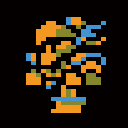
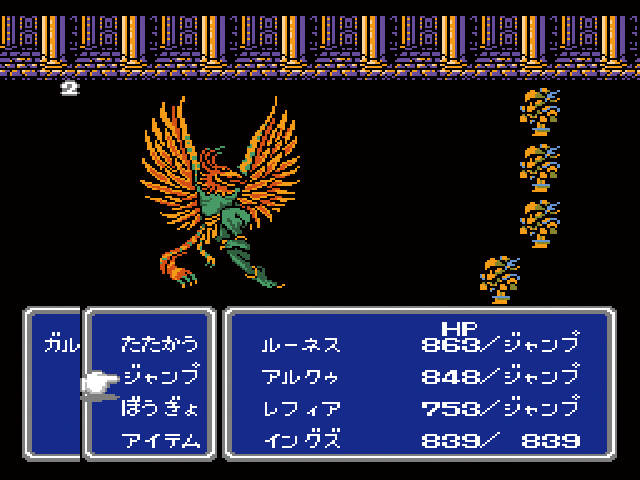
Tanaka: More than anything I feel like it was just ideas that came to us out of the blue. I think that in our head, we envisioned the dragoon grabbing on to the leg of a wyvern or something, then falling down from the sky. Although perhaps Mr. Ishii’s original vision was more a traditional dragoon mounted infantry. We ended up with this image of riding a dragon like a horse, only it’s a flying dragon.
―Is there a job you like best?
Tanaka: Oh, that would be onion knight. When I saw Mr. Ishii’s illustration my first thought was, “Come on, this is an onion.” [laughs]
It looked like the cluster of flowers that bloom from onion stalks, so I think the idea came from there. That’s how it got the name “onion knight”; there was no hesitation.
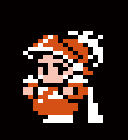
―Which scene from FFIII is the most memorable for you? Were there any that you were especially particular about during the development process?
Tanaka: The scene we took the most care with has to be when you leave the first continent and head out into the world outside, into the world that’s all ocean. That sense of vast, open space is something we really wanted to get just right.
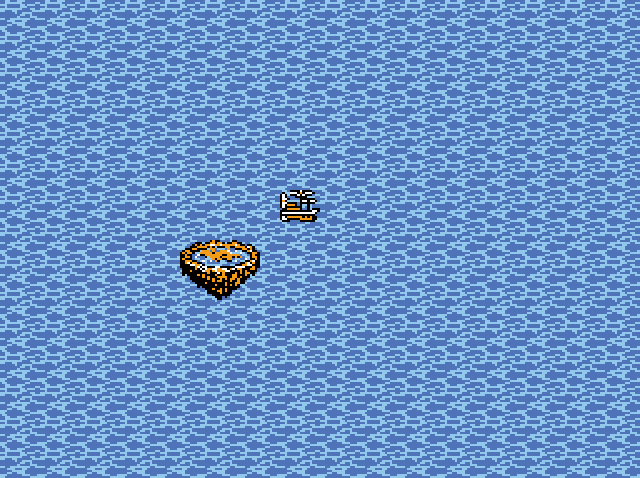
―That scene left such an impact. I can remember thinking how incredible it was that, despite having a pretty substantial adventure just on the floating continent, there was still a whole other even more expansive world out there.
Tanaka: Well, we already decided that was how the story would go, so like I said before, we hadn’t considered things like why the people on this continent that had been at the bottom of the ocean were just suddenly living normal lives after it surfaced. “Just say they had been petrified,” is what somebody suggested. [laughs]
―The NPCs in FFIII do things like follow the player.
Tanaka: Yes, the NPCs’ presence felt a little weak if it’s just the player progressing by themselves, so we decided to let NPCs join the party as guest characters.
―I see. But unlike previous titles they no longer fought alongside you.
Tanaka: That’s because we wanted to prioritize the player characters’ strength, or rather we couldn’t know how strong the player would be when an NPC joins their party. We might have been able to do some calculations to make it work, but we decided to design that part without battles as a factor.
―The four old men are pretty memorable. They had a lot of character.
Tanaka: Those came from Mr. Sakaguchi; he loves old man characters. No matter what, he’s always wanting to put old men in his games. [laughs]
―Personally, when it comes to you, FFXI is another title I have strong impressions of. It feels like your involvement in FFIII was a factor in the creation of FFXI – is there any truth to that?
Tanaka: Hmm... To me, FFIII’s development was when I put the most effort into creating FF’s game system. FFI through FFIII used the same table for the player’s growth curve. That table was also used in Xenogears years after the fact.
But FFXI had a system totally unrelated to that. FFI through FFIII established a specific world for FF, and that created a pretty solid structure when it came to how magic and jobs and the like worked. I think that maybe FFXI is when we reworked all that.
I feel that after FFIV, FF kind of became a story-centered series if anything.
FFII’s battle system was left entirely up to Mr. Kawazu, so it’s a little different, but how do you say, there’s the same logic in FFI and FFIII. For the “cure” spell, for example, I created these sort of parameters and ratios for calculation that are used throughout those games.
―There are a lot of design documents you put together still left at SQUARE ENIX.
Tanaka: That actually started with FFIII. After making FFI and FFII we realized, “Oh, there’s not any documentation left.” [laughs]
With FFIII, we decided to create an official project plan, organize all the materials in a binder and archive it properly. Mr. Sakaguchi started keeping physical drafts of things he had thrown together in a map editor. I think part of that was [DRAGON QUEST creator] Mr. Yuji Horii’s influence, because he didn’t use a computer – all his maps were hand drawn. We saw that in a collection of project plans and realized we should do things the same way.
―I’m sure part of it had to do with data size issues during the development of FFI and FFII, but it felt like those games weren’t exactly kind to the player at times. With FFIII, though, in terms of where to use what jobs, when to do what, what to do next...it feels like there were more of those pointers given to the player in FFIII.
Tanaka: There were some parts where I feel like we gave the player a little too many specific provisions, that there wasn’t enough freedom. The dark knight dungeon had that exact issue: you can’t clear that if you aren’t able to make good use of the dark knight job. There was no way for the player to choose jobs and parties of their own volition, so everyone ends up using a party of only ninja and sages in the final dungeon. Things like that.
―So from the creator’s perspective, it was actually something that you weren’t sure about.
Tanaka: Yes. FFXI’s job system was born out of reflections on how to improve on that problem. We wanted the player to be able to face the final fight against the Shadow Lord no matter what party they had.
―Even so, FFIII’s system allowed the player to change their job without resetting their level, so it felt like it gave you a lot of freedom. Although when push comes to shove, you’d run into trouble if you didn’t have job points saved up.
Tanaka: For that we used a job grid where, for example, changing to a job that’s considerably different from your current one, like warrior to black mage or white mage to black mage, would use a lot of points. We didn’t want a system that just gave the player total freedom; we wanted players to know that certain job changes were and were not suited to each other. In FFXI we got rid of that and gave players the freedom to change jobs whenever they wanted to. I suppose that was backlash from FFIII. [laughs]
―There were many jobs, but without a specific goal you might have gone through the whole game having never switched. So it feels like having points where you couldn’t progress without changing jobs made the player try different things.
Tanaka: We went to all that trouble creating all these jobs, so we did want people to try various things. There may have been some parts that were a little heavy on pigeonholing the player with specific conditions, though. You’d never change jobs if there wasn’t a need to.
―Was there anything else you struggled with?
Tanaka: It was all a struggle. [laughs]
It goes to follow that more data to work with means more things you can do, and naturally you want to use that data to its fullest potential. In trying to do that, we’d end up with one bit too few or one bit too many and things like that. There were times where we had to change parts of FFIII’s world and story and so on to compensate.
Oh, and as for something that we had trouble with making FFIII, there’s one good story. Right in the middle of development our main programmer Nasir Gebelli’s visa expired. He was living in a rental condo in Aoyama at the time, but he moved from there back to America. [laughs]
We still had about two months until the master of the game would be ready, so we said, “Well, what else can we do? Let’s go to him,” and packed up the PC and NES and all that and went to the United States. Obviously we were a bunch of Japanese people with all this suspicious technology, and Mr. Sakaguchi got held up in customs at San Francisco. The rest of us said we were there for business and got in just fine, but maybe he told the agent he was just sightseeing or something. [laughs]
―Was there any part of working on FFIII that ended up influencing you after the fact?
Tanaka: FFIII was a considerable challenge, but making a game where the monsters and player characters are lined up together on one field - that made me want to make those characters move around actively, and that led to things like the creation of Secret of Mana. Secret of Mana was originally designed with the same system as FFIV, but it ended up where FFIV got the ATB (Active Time Battle) system, which was kind of action-command style, and Secret of Mana got what you might call motion battle that put the commands in a ring formation. Both were trying to evolve in the same direction, adding real-time elements to command-based RPG battle systems, but Mr. Sakaguchi really wanted to keep the way player characters were displayed on the overworld as 16×16 square pixel art all the time, maintaining the game world’s “miniature garden” feel. I felt that it would be good to display the characters as they are in battle, slightly taller 16×24 dot pixel art characters, even out in the overworld. That was something we disagreed about, hence me leaving the FFIV project.
Mr. Sakaguchi was set on still using those smaller NES-era pixel art characters despite the ability to display in a better resolution and with more expressiveness on SNES, I really didn’t get it. I suppose he was just very attached to that “miniature garden” feel that emphasizes a world that feels vast and expansive. After FFIII that may have been what made me start thinking that I should pursue projects I wanted to make that weren’t FF.
―Thank you for your time today!
・Part two of the FINAL FANTASY III 30th Anniversary Special Interview is available here.
LOGO & IMAGE ILLUSTRATION:© YOSHITAKA AMANO